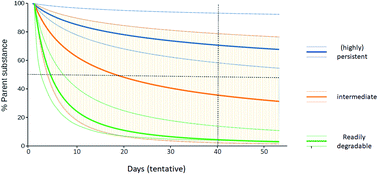To be or not to be degraded: in defense of persistence assessment of chemicals
Abstract
Characterizing the degradation behavior of chemicals in the environment is a key component of chemical hazard and risk assessment. Persistence has been successfully characterized for readily and for slowly degradable chemicals using standardized tests, but for the third group of chemicals with intermediate degradability (“middle group”), the assessment is less straightforward. Whether chemicals of this group behave as persistent or not in a given environment depends on environmental factors such as the presence of sorbents that can limit the bioavailability of chemicals. Uncertainties associated with current persistence assessments of chemicals in the middle group do not imply that persistence assessment is generally inconsistent, too ambiguous for regulatory use, and not useful in chemical hazard and risk assessment. Given the complexity of the environmental factors influencing chemical degradation, and the diversity of commercial chemicals, it has to be accepted though that for chemicals in the middle group even improved testing methods will not remove all of the immanent heterogeneity in their persistence data. For cases with widely different but technically valid persistence data, a weight-of-evidence approach is necessary and the “benefit of the doubt” should follow the precautionary principle in order to protect human and ecosystem health. We maintain that technically valid persistence data, although they might be considered dissatisfying from a scientific point of view because of high variability or even inconclusiveness, can well be sufficient for regulatory purposes. As with anything, also in persistence assessment, the scientific logic aims for a mechanistic description of the processes involved, low uncertainty, and a comprehensive understanding derived from a broad empirical basis. If the scientific logic is used as a benchmark in the regulatory context, this may easily lead to “paralysis by analysis”. While regulatory decisions should be based on sound science, discrepancies between scientific goals and regulatory needs and, consequently, different levels of requirements (must-have versus nice-to-have) for degradation studies need to be recognized and appreciated. We further advocate for enhancing consistency between regulatory persistence assessments (“one substance–one assessment”), which is currently not the case.

- This article is part of the themed collections: Recent Open Access Articles and Environmental exposure and impacts


 Please wait while we load your content...
Please wait while we load your content...